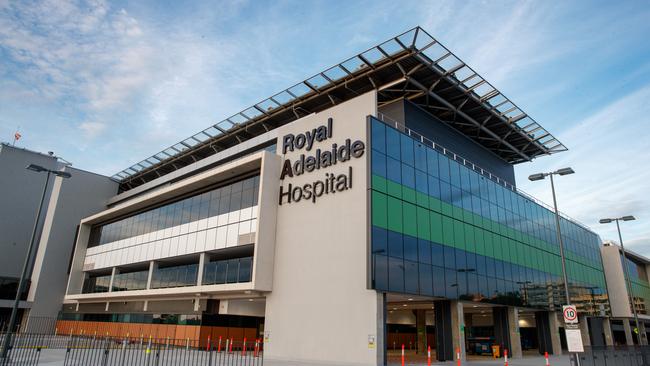New Royal Adelaide Hospital still has teething problems but easing into new flagship role
IT’S been a little more than two months since the $2.3 billion Royal Adelaide Hospital opened. It’s been a huge change for staff and patients — so is the system coping?
SA News
Don't miss out on the headlines from SA News. Followed categories will be added to My News.
- Major hospital emergency departments as system struggles
- So how’s the new RAH’s food? Not all that crash hot ...
- Medication stocks at some RAH wards are dangerous low
- Legal action over new RAH blamed for large drop in likely investment
JUST over two months since opening, the $2.3 billion Royal Adelaide Hospital continues to struggle with “teething problems”, including staff dealing with the new electronic patient record system.
Pressure on the health system, partly due to a record flu season, continues to see the RAH Emergency Department operating at Code White on occasions — more patients than beds in the 65-capacity department.
Bed blocks also continue to mean variable delays in being admitted. On Friday afternoon, there were 18 patients who had been treated and had been waiting between 12 and 24 hours for a bed.
On Saturday afternoon, only five patients had been waiting that long.
The public hospital doctors’ union, the SA Salaried Medical Officers Association (SASMOA), says the Government’s controversial electronic health records system EPAS is part of the problem. The over-budget, behind-schedule system has been criticised by medical staff and has seen productivity figures drop in hospitals where it has been introduced as staff spend time dealing with the “clunky” system.
SASMOA spokesman Dr David Pope says the introduction of EPAS at the RAH when it opened has slowed staff who were still coming to terms with the system as well as working in a new building.
“Certainly, the efficiency at the RAH has been reduced significantly as staff use EPAS,” he says. “It (EPAS) is difficult and time-consuming to use, it’s difficult to get the right information and difficult to get information out of it.
“Staff are not turning people over as fast as they otherwise would.”
Dr Pope also notes the closure of the Repat and hospital downgrades at Modbury and Noarlunga are having “flow-on effects through the whole system”.
“The EDs are not big enough, the RAH in general is lacking important capacity at the time it opened — that’s a big concern going into the future,” he says.

SA Health deputy chief executive Don Frater told a Committee for Economic Development of Australia forum on digital health the EPAS rollout was going fairly well but notes there is the “60-year-old clinician who doesn’t want to change, who doesn’t like the fact we are providing them with computers and IT that forces them to do a cultural change”.
“For them, this will be slower and harder, and we need to recognise that,” Mr Frater says.
However, he predicts the single system will prove its worth in the long term, compared with Victoria, NSW and Queensland, which opted for individual systems for hospitals that do not talk to each other.
“In Victoria, there are probably 50 different systems operating in the state and if you go from one hospital to another you have to repeat all the data again,” he says.
“We will have one record system. It’s hard to do that, it’s more complex but the outcomes for the community will be better.”
The RAH ED now is dealing with an average of 200 people a day and is increasing the number of elective surgeries, following the ramp down of elective surgery for the move and to address winter demand.
THE new automatic pharmacy dispensing system designed to reduce errors in patients receiving the wrong drug or an incorrect dosage is in operation and officials say: “As you would expect with any new systems, adjustments have been made to ensure it operates efficiently to meet demand.”
They also say the Rahbots are performing as expected as automated delivery platforms, and that early problems with food ordering technology — resulting in late arrivals of meals — have been overcome.
The latest catering report, of November 9, shows meal delivery time frames are the same as they were at the old RAH, with more than 2000 meals made and delivered on site each day.
New RAH activation executive director Paul Lambert says he is proud of everyone who worked hard to make the move to the new Royal Adelaide Hospital a success.
“We are continually striving to resolve any issues that arise and thank staff, patients and visitors alike for their patience as we adjust to our new home,” he says.

“We have received some wonderful feedback from patients, who are particularly impressed with the single rooms. It’s also heartening to see so many people enjoying our green spaces and enjoying more time outdoors.
“I’d also like to acknowledge the work of our Centre for Creative Health team who, through artwork and the ever-popular piano, have enhanced our patient experience.
“Seeing South Australians embrace the new Royal Adelaide Hospital is testament to how a world-class facility can improve health outcomes for an entire community.”
Arthur Mathews has dialysis three times a week at the RAH, travelling with his wife, Maureen, from Murray Bridge for treatment and returning home each weekend.
“I love it; it’s easier for us than the old RAH,” Mr Mathews says.
“It’s easier parking for me, I just park out the front of the Dialysis and Day Treatment Unit and walk straight in.
“I found the old hospital gloomy and I think its time was up.
“The care was there, but it was old and tired.”



